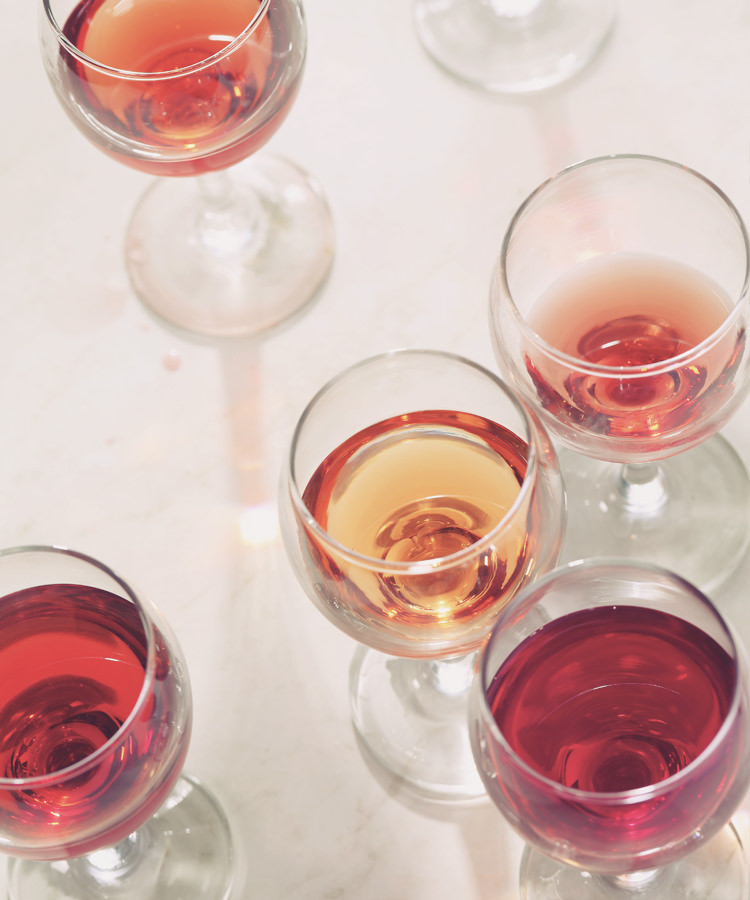Spring might be the most fragrant time of year. After a long, sleepy winter, everything is in bloom once again: flowers, grass, produce, even people. It seems only appropriate to drink floral, spring-scented wines to celebrate. There’s actually a reason that some grape varieties are more aromatic, floral, and springy than others. It’s all thanks to something that falls under the category of wine geekery: terpenes.
We know what you’re thinking: an unfamiliar, scary wine term! Hear us out. Terpenes, simply put, are organic compounds that give plants intense, distinctive aromas. They are usually found in a plant’s essential oils or in a grape’s skins. They’re responsible not only for intensely scented wines but for pine-scented conifers (what would the holidays be without that Christmas tree smell?), differing hops aromas (hello, IPAs!), and even the aromatic diversity of marijuana. So really, terpenes are a great thing to have around! Now, science nerds can have a field day studying the influences of each individual type of terpene (geraniol smells like rose and spice! Cintronellal smells like lemon and eucalyptus!), but the thing the rest of us need to know is that terpenes tend to give wines intense floral, sweet citrus, and spice aromas.
Most if not all wine grapes contain terpenes. But some have higher concentrations than others. These are the wines that can be confidently described as floral, the ones with that jump-out-of-the-glass aromatic profile that makes the entire room smell like potpourri. This is also one of the things that makes terpenic wines polarizing; there’s no escaping the floral aromas, so you’ve got love them, or you’ll hate them. This is also why wines like Riesling that have a good amount of terpenes but are a bit more restrained are more crowd-pleasing than the super-concentrated varieties; they have enough aromatic complexity to be interesting, but aren’t as in-your-face.
Because there are so many different types of terpenes, exploring terpenic wines is like walking through a thickly planted meadow. One corner may bring about softer scents of daffodil and honeysuckle, while the next turn will be flooded with jasmine and rose. To fully embrace the springtime flower child that you are, try wines made from these five terpene-laden grape varieties and get ready to wow your picnic buddies with your nerdy wine knowledge.
Muscat
While often thought of as a single grape, Muscat is actually a family of grapes, and that family contains the most aromatic, terpene-rich grape around: Muscat Blanc à Petits Grains. In fact, this was the grape that scientists in the 1940s chose in order to study and understand terpenes as a whole. Muscat Blanc à Petits Grains is incredibly versatile, making the softly sweet, frizzante wines of Moscato d’Asti, the versatile, dry-to-sweet wines of Alsace, and the fortified Muscat de Beaumes-de-Venise. Overall, the wines tend to be extremely fragrant, with a melange of jasmine, lily, freesia, and rose, along with intensely ripe fruit and a certain grapey quality.
Gewurztraminer
Winner of the “most fun wine to pronounce” award, Gewürztraminer has incredibly distinctive, terpene-derived aromas and is considered one of the most floral wines available. Lychee is the most common descriptor associated with Gewurztraminer, along with rose, lavender, lilac, and ginger. Full-bodied and low in acidity, Gewurztraminer is a grape that does well with extended skin maceration, which is potentially a reason for the higher concentration of terpenes, as these compounds are found in grape skins. While the name of the grape sounds definitively German, Gewürztraminer is actually found more often in the Alsace region of France, as well as Italy’s Alto Adige and in the U.S.
Torrontes
While Argentina may be more well known for red wines, its signature white wine is an aromatic doozy. Torrontes is an extremely perfumed wine, with potpourri-like floral aromas: white flowers, lavender, and beyond. There’s even a bit of a soapy quality to the florality, like the lily blossom/fresh cotton-scented hand soap that your mom stocks in the guest bathroom. Though Torrontes is often grown at high elevations in Salta to combat the warm climate, there is still plentiful sun, so expect loads of tropical and ripe citrus fruit, but with plenty of acidity.
Viognier
Just the word “Viognier” evokes visions of posh flower gardens. Obviously floral it may be, but Viognier manages to be softer and richer about it, with aromas of honeysuckle, daisy, jasmine, and orange blossom. It can get a touch soapy as well but is far more elegant, particularly in the northern Rhône’s famed Condrieu appellation. Fuller-bodied and viscous, with ripe citrus and peach fruit, Viognier sometimes has a touch of new oak to complete those bass notes, especially in New World examples.
Syrah
It’s not just white grapes that can be terpene-heavy; red grapes have terpenes, too, and Syrah in particular is characterized by a certain member of the terpene family: rotundone. Rotundone is found in the essential oils of several spices and herbs, most distinctly black pepper, and it is the reason why Syrah is known for having a noticeable black pepper aroma, along with violet and organic, earthy scents from other terpenes. The most peppery styles of Syrah are found in the northern Rhône, which tends to have more restrained black fruit, allowing the spice and floral aromas to shine through, but it’s detectable under the jammy fruit and oak of Australian Shiraz as well.
